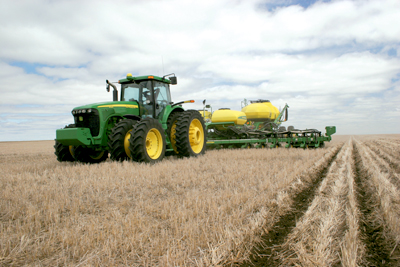
No-till farmers can move residue with row cleaners, apply liquid pop-up fertilizer and place liquid nitrogen in a band 2-3 inches from the seed zone using a fertilizer opener.
Editor's Note: "Ahead of the Curve" is a new column designed to present dealers with leading-edge agricultural technologies and production trends to help them anticipate opportunities for increasing equipment sales by helping farmers increase their efficiencies and profits. Columnist Phil Needham is president of Needham Ag Technologies, an agronomic consulting firm located in Calhoun, Ky.
Ask a farmer what his greatest concerns are this cropping season and it's a safe bet that many — if not most — will tell you that high fertilizer and fuel prices top his list. Many speculate that grain prices won't stay high. And as they subside, the high cost of energy intensive fertilizers and fuel will remain.
Sound Familiar? Whether or not this scenario holds true, dealers need to be looking at opportunities to help producers maintain yields and control input costs. Your customers are looking to you for help.
There are several viable efficiency boosting options in practice these days. Most involve the use of conservation tillage practices and different fertilizer placement options. These include minimum tillage, strip-till, no-till and no-till with fertilizer placement.
Following is a brief rundown of each of these practices and a newer technology that is helping growers reduce input costs while maintaining or improving crop yields.
Minimum Till and One-Pass. Many producers have ripped or chiseled ground in the fall and followed this up by discing and/or cultivating in the spring. Unless a significant soil compaction problem exists, there are few benefits to fall tillage. Where some tillage may be needed, many producers have transitioned to a one-pass system that is done in the spring.
Strip-Till Still Evolving. There are many interpretations of strip-till and its final configuration is still evolving. Early strip-till units consisted of ripper shanks, which frequently caused depressed seed zones in the spring. But most strip-till units today consist of discs that till a thin strip ahead of planting the following spring.
Successful strip-till systems consist of a fertilizer placement system that can locate a band of fertilizer where the following corn row will be planted. However, research has shown that unless tractors are equipped with high-accuracy RTK auto-steer systems, fertilizer placement can be compromised and strip-till's yield benefits quickly deteriorate. The big challenge with regard to strip-till is the time required to complete the operation.
For example, one producer that purchased the latest and greatest strip-till equipment never had time to run it before the land got too wet in the fall.

Nitrogen, phosphorus and potassium can all be positioned according to soil tests using a three-compartment commodity cart.
Cost-Effective No-Till. Provid-ing the producer's fields have above-average drainage, no-till provides the most cost effective and efficient method of establishing a crop.
Among the benefits of no-till are fewer spring passes across the field, which reduces soil compaction and raises yields. Providing a planter is equipped with appropriate attachments, such as row-cleaners, soil warming can equal that of strip-tillage.
No-Till with Fertilizer Place-ment. The most efficient system that is just beginning to emerge in several areas of the country, most notably in the Dakotas, is a one-pass system called "no-till with fertilizer placement." As different areas have various preferences with regard to the types of fertilizer they utilize, system configurations in these units can vary significantly.
Some producers are opting to place nitrogen (N) in a band alongside the seed row at planting time, which is very effective, especially in cooler no-till environments. This system is practical for many producers as they can either carry a tank on the tractor or planter, or even pull a trailed tank behind the planter. But this means a producer must still place phosphorus (P) and/or potassium (K) within the soil, preferably in a band close to the seed row.
Using a Commodity Car. What these growers are finding is that it's best to place all the crop nutrients in a band alongside the row at planting time with a commodity cart. With all of the advances in yield mapping, soil type productivity values and site-specific soil sampling, the next opportunity to push this technology further is to couple it to variable rate application technology.
This allows for the delivery of specific rates of N, P and K in accordance to yield potential within the different soils and topographies of a field.
If fertilizer prices stay high, many producers will be encouraged to band fertilizer prior to planting or during the planting process. Research shows that availability is higher and rates of fertilizer can be reduced — in the short term anyway. Banding fertilizer at planting is the most efficient and least labor-intensive option. So dealers and farmers should work together to configure planting and seeding equipment to increase yields and control fertilizer and fuel expenses.





